MACON – Mercer University has issued an open Request for Qualifications (RFQ) for artists or teams of artists to submit proposals to create and install a new permanent outdoor sculpture to commemorate the institution’s integration, a process that began in 1963 and continues to this day and into the future.
The sculpture was approved on the recommendation of Mercer President William D. Underwood at a meeting of the University’s Board of Trustees Executive Committee in June. Also at that meeting, a 10-person committee was named to retain an artist and work with that artist to develop a design for the sculpture.
Applications should include a 500-word concept statement; drawings, sketches or renderings of the proposed original artwork; a proposed budget; proposed fabrication methods; a resume, CV or bio; examples of previously completed public art; a link to the artist’s website and/or social media accounts; and three professional references.
Application materials should be combined in a PDF and submitted to Shawna Dooley, associate vice president for University advancement, at dooley_sr@mercer.edu. The RFQ closes Feb. 15, 2021.
The committee will consider applications, select finalists, and host site visits and interviews this spring, before notifying the selected artist or team over the summer. The sculpture will be fabricated over the following 12-14 months with a public dedication ceremony anticipated in fall 2022.
The artwork will reside on the Macon campus near the historic quad on a 120-foot by 60-foot greenspace that previously served as the site of the recently demolished Computer Science Building.
“The sculpture is envisioned as a way to celebrate the remarkable story of Mercer’s integration in a way that highlights both how the students felt and what they did,” reads the RFQ, which recounts the story of the University’s integration. “As doors of opportunity were finally opened to them, the pioneers of the 1960s took the first steps in a relay race for equality in education. The baton is repeatedly passed to the next emerging generation and the work continues.”








